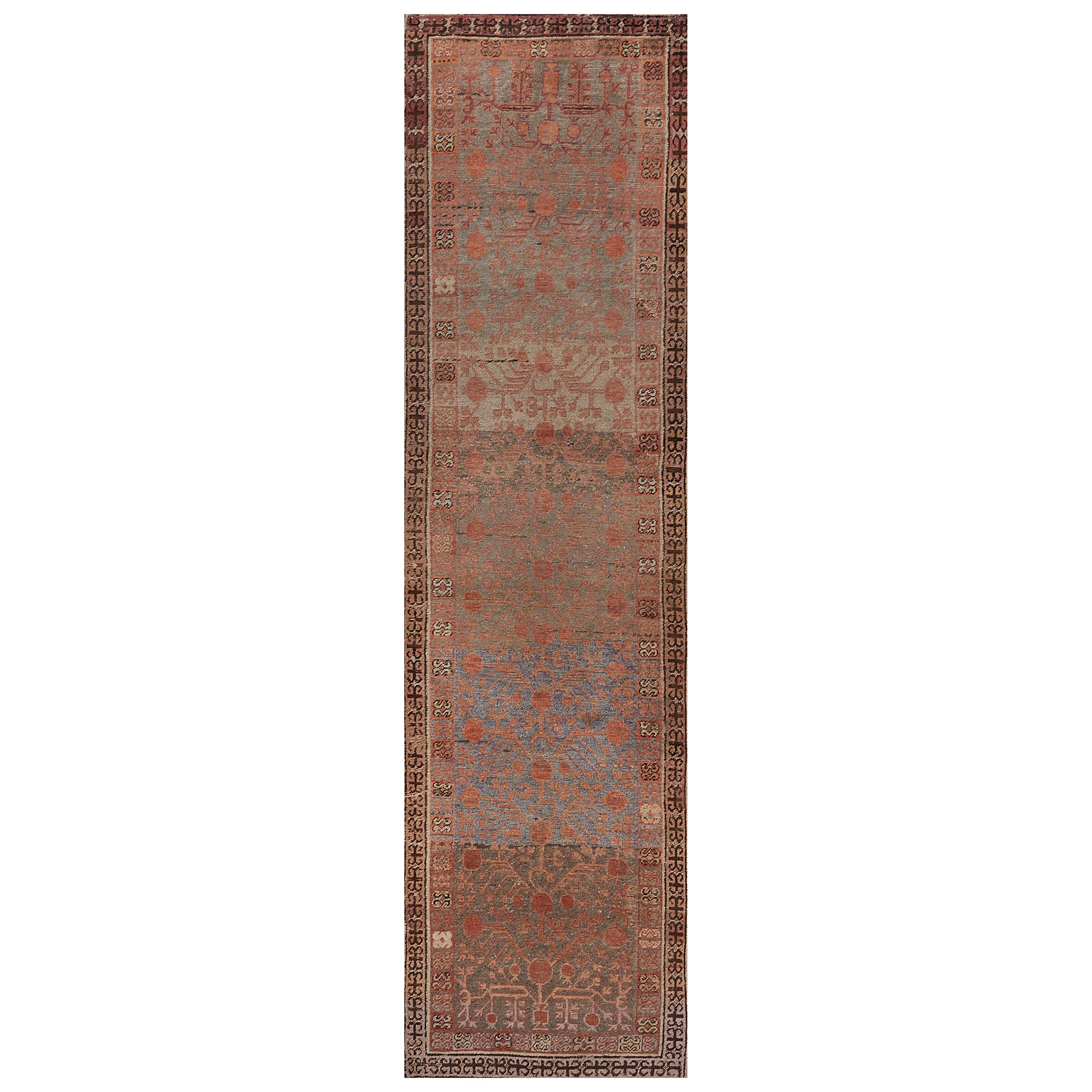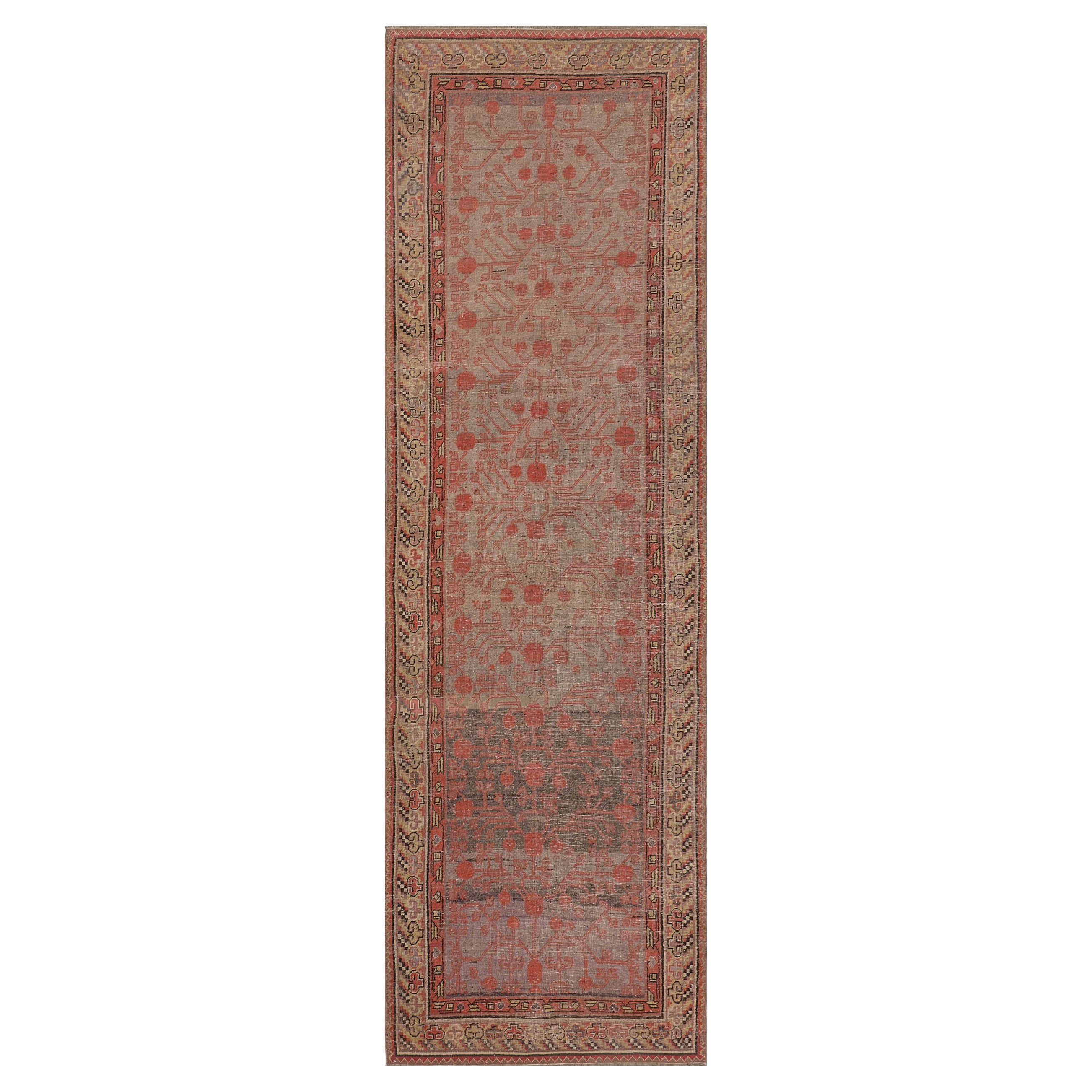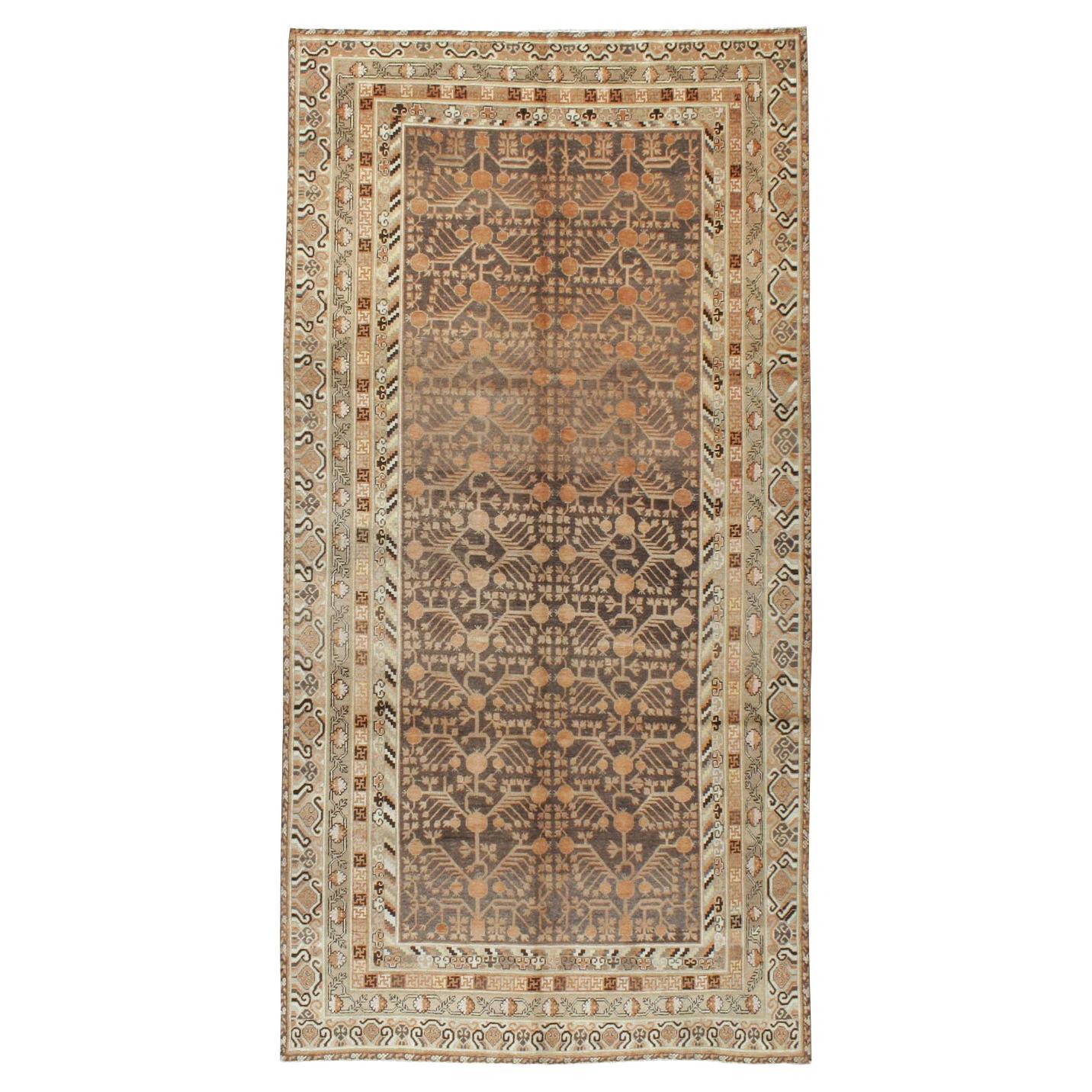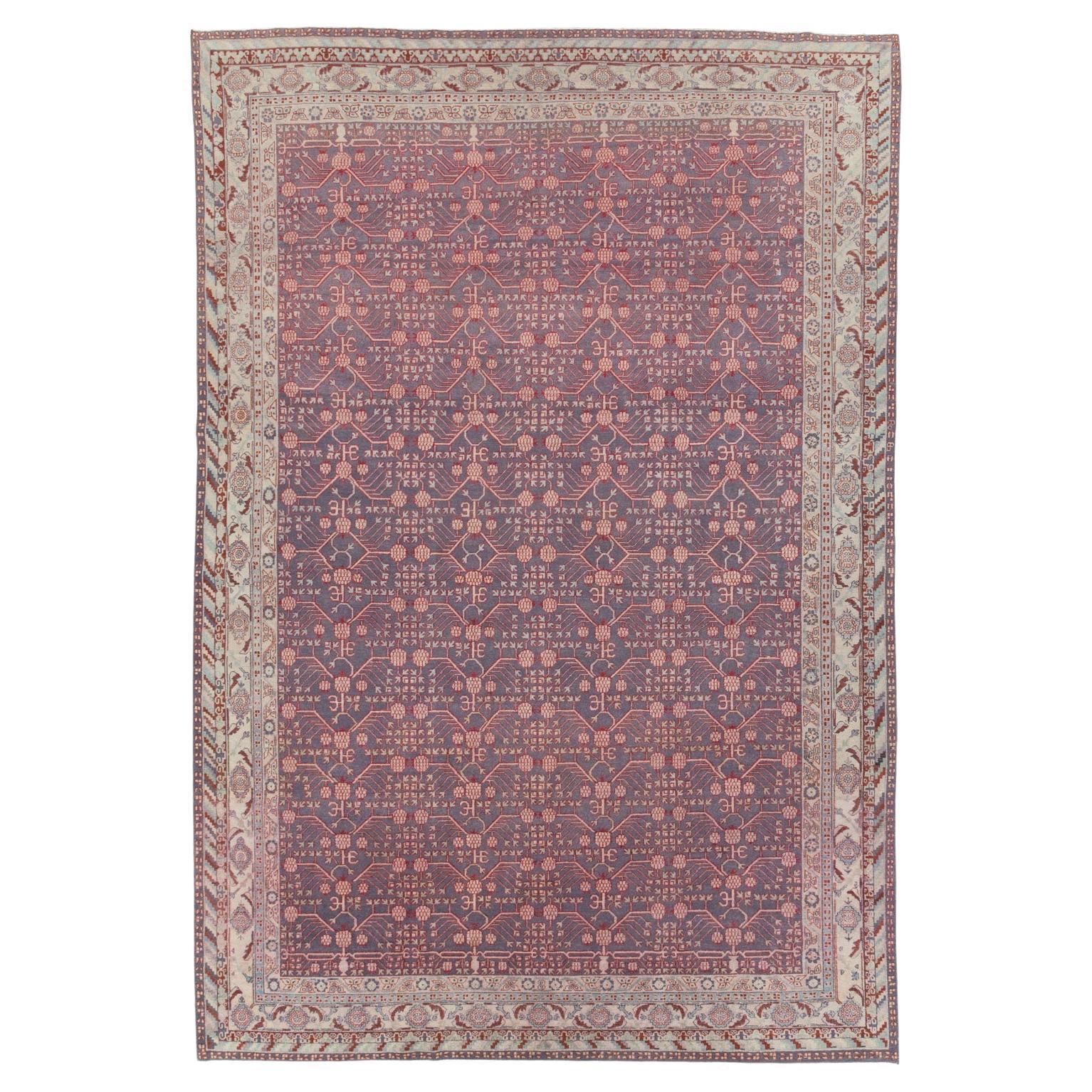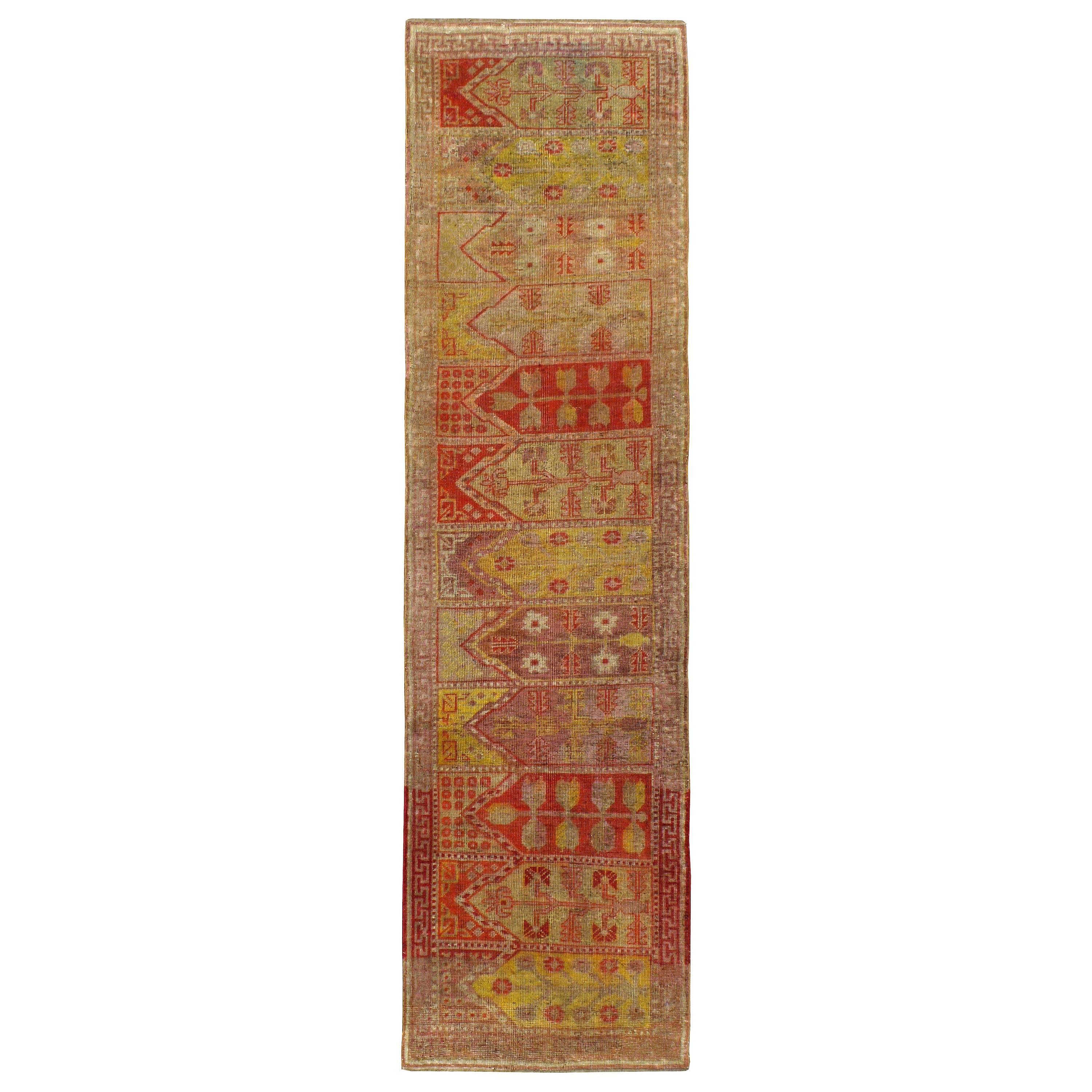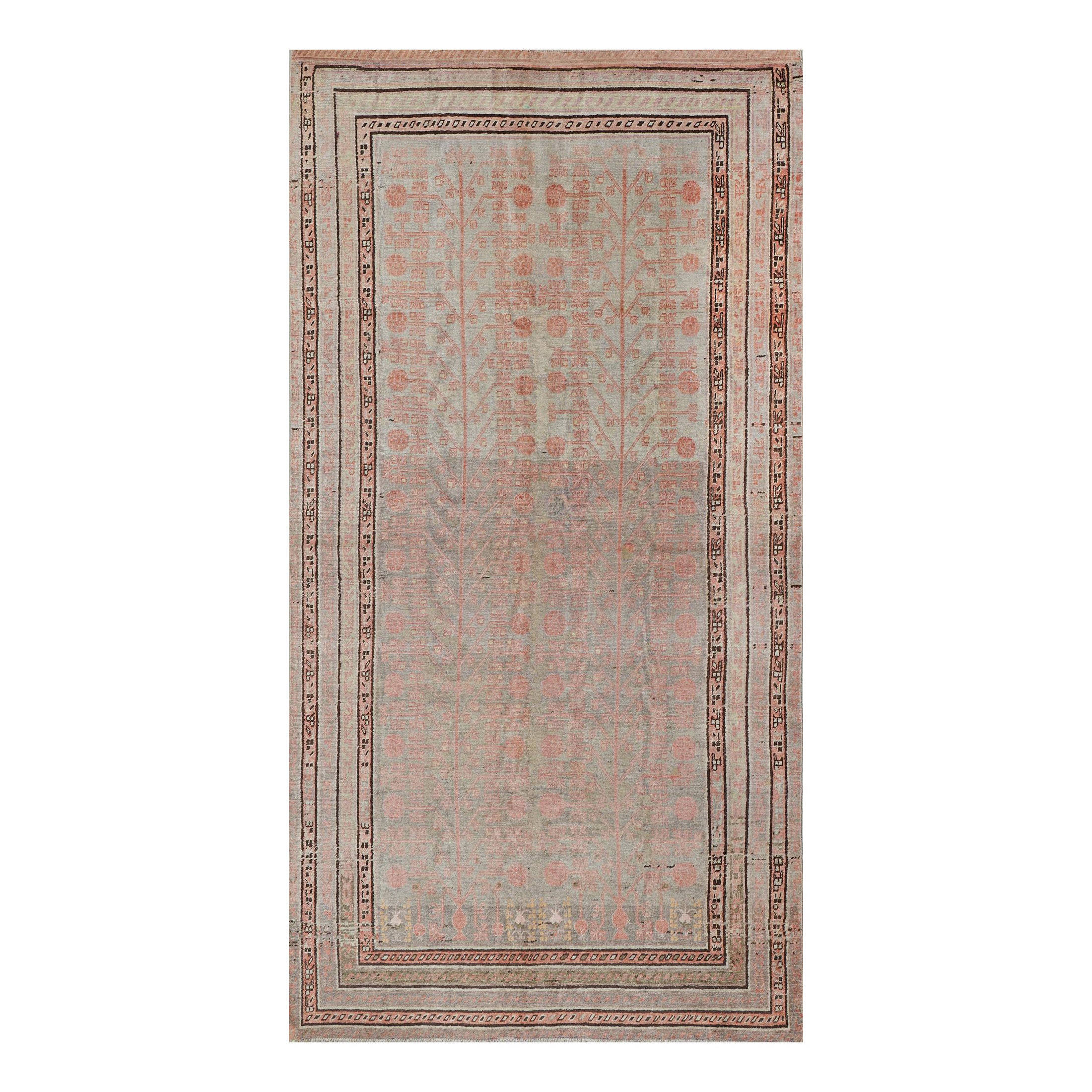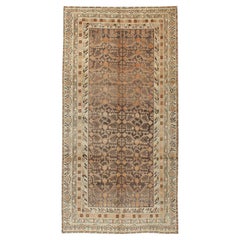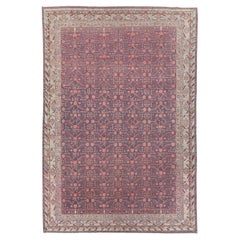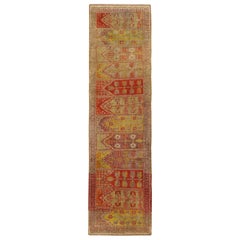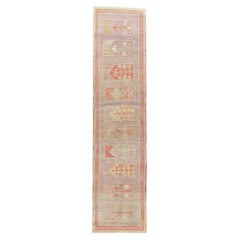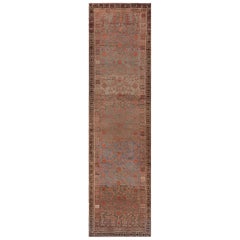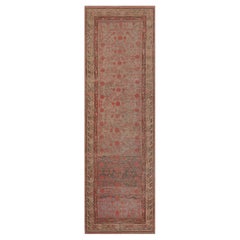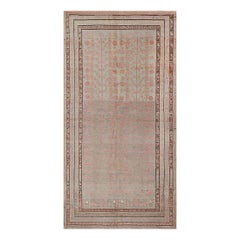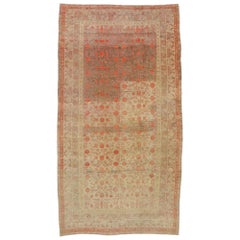Items Similar to Early 20th Century Handmade East Turkestan Pomegranate Khotan Runner
Want more images or videos?
Request additional images or videos from the seller
1 of 9
Early 20th Century Handmade East Turkestan Pomegranate Khotan Runner
$4,125
£3,131.63
€3,581.92
CA$5,763.22
A$6,409.96
CHF 3,347.08
MX$78,002.42
NOK 42,747.36
SEK 40,089.48
DKK 26,733.21
Shipping
Retrieving quote...The 1stDibs Promise:
Authenticity Guarantee,
Money-Back Guarantee,
24-Hour Cancellation
About the Item
An antique East Turkestan Khotan rug in runner format with a pomegranate design handmade during the mid-20th century.
Measures: 2' 2" x 7' 6"
Central Asian Rugs & Carpets:
Central Asia is a vast area stretching from Northeastern Persia to western China, and from northern Afghanistan to the southern edge of Russia. The carpets can be usefully divided into three groups: the nomadic Turkmen rugs of Turkmenistan, northern Afghanistan, and northeastern Persia; the non-Turkmen tribal pieces from Kazakhstan, Uzbekistan, and Kirghizstan; and the urban creations of Khotan, Yarkand, and Kashgar, oasis cities of Western China (Xinjiang Province).
Commercially, the most important group is from Khotan, the easternmost of the Chinese Turkestan cities. The craft of rug weaving is primarily in the hands of Muslim Uighurs. Khotan carpets mix purely Central Asian design themes with Chinese elements. Native Khotan devices include pomegranate trees, upright flowers, round medallions, and yellow or red grounds. Chinese motives include triangular fretwork corners, swastika fretwork, and Yun-Tsao Tou (clouds and rain) diagonally striped polychrome borders. Cotton foundations, asymmetrical (Persian) knots, and medium weaves are standard. Some vintage Khotan are in horizontal, pictorial layouts with multiple various vases and plants. Saphs (multiple prayer niche panel carpets) are also a Khotan specialty. Others employ stepped and layered lozenge medallions, singly or in pairs. Still others, almost all antique, feature a stylized version of the allover Persian Herati design. Many of the oldest pieces employ brown wool wefts. Antique and vintage Khotans are almost always in the k’ang (double square) layout, conforming to the local household plans. Only relatively recently has the 6’ by 12’ or 7’ by 16’ format been replaced by the 9’ by 12’ size. As a result, an antique room size Khotan carpet is very uncommon. Reds are cinnamon, tomato and rust, never wine reds, crimson, or scarlet. Yarkand, farther west on the old Silk Road specializes in multi-medallion long carpets while Kashgar, farthest west and most under Persian influence, has traditionally knotted allover pattern pieces with finer weaves, often with silk piles, and enriched with medal thread, on cotton foundations. Extant Kashgars go back to the 17th century, but the carpet craft in Chinese Turkestan must be much older as fragments have been recovered from local tombs of the early C.E. period. Kashgars are the rarest of all East Turkestan rugs. Most available vintage East Turkestan carpets are interwar Khotans, many with pleasingly soft decorative palettes.
The non-Turkmen nomads include the Kazakh, Kirghiz, Uzbek, and Karakalpak groups. Like the Turkmen, they were once all seasonally migratory, dwelling in round felt tents (yurts), but have been settled, at least partially, in the villages, and have taken up crafts and agriculture instead of sheep herding. As a result, carpet production has transitioned from domestic tent use to commercial sale, but the roots of long traditions are still evident. The Uzbeks weave carpets in the general Ersari “gul” Turkmen style, but wilder and less disciplined, suzanis (needlework) hangings and covers, and silk ikats in the cities of Bokhara and Khiva. The Karakalpaks weave “gul” rugs, somewhat in the Turkmen style, but heavier in handle. The Kirghiz knot red and blue allover pattern carpets with wool foundations, and often with Chinese design influences, while the Kazakhs, many still nomadic, weave a variety of conjoint strip rugs (julchirs), long pile “gul” carpets and shaggy tent paraphernalia. Generally all-wool construction, moderate to coarse weave, asymmetric (Persian) knots.
The Turkmens, the archetypal Central Asian tribal people inhabit Turkmenistan, northeast Afghanistan, and Northeast (Khorassan Province) Persia. They are divided into the Tekke, Saryk, Salor, Yomud, Chodor, Ersari, and distinct smaller tribal groupings. The most important, rug wise, are the Tekkes around Ashkabad in Turkmenistan, the Yomuds on the east side of the Caspian Sea, and the Ersaris from Northwest Afghanistan and Uzbekistan. All the tribes weave “gul” carpets, carpets displaying their emblematic tribal medallions (“guls”) repeated across, and up and down the field. Fields are generally in shades of red, ranging from tomato to rust-brown to coral to aubergine (eggplant) to wine. Accent tones include dark and light blue, burnt apricot, and ivory. Guls may be large or small, stretched, elliptical, beveled squares or truly octagonal. Also, a range of lesser pieces is woven including ‘ensis (tent doors)’ usually in cross layouts and scatter sizes, large and small bags, tent bands, and various domestic paraphernalia for their tents. The Ersari also weave long ‘kellegi (gallery format)’ carpets with geometric Persian allover patterns including the Herati palmette, Harshang, and cloud bands. These, mostly antique, rugs were made for the houses in the cities of Bokhara, Khiva, and Samarkand. Tribal weavers, urban clientele. Both Turkmen and Non-Turkmen tribal carpets generally range up to seven by ten or eleven feet, except for longer Ersaris. A true modern room size is rare. Generally all-wool construction, coarse to ultra-fine weave, symmetric (Turkish) or asymmetric (Persian) knots.
Contemporary weavers in Afghanistan have begun to weave larger, very attractive carpets combining Turkmen, Caucasian, and Persian pattern elements. It will be interesting to see where this recent development goes. These carpets should age well into desirable antiques.
Although the carpets of Central Asia may share common places of origin, they are so diverse that they require extensive study within each group. They have never gone out of style in Western homes.
- Dimensions:Width: 26 in (66.04 cm)Length: 90 in (228.6 cm)
- Style:Modern (In the Style Of)
- Materials and Techniques:Wool,Hand-Knotted
- Place of Origin:
- Period:
- Date of Manufacture:Early 20th Century
- Condition:Additions or alterations made to the original: This carpet has been professionally antique washed to soften its tonality.
- Seller Location:New York, NY
- Reference Number:Seller: 169161stDibs: LU882324633042
About the Seller
5.0
Gold Seller
Premium sellers maintaining a 4.3+ rating and 24-hour response times
Established in 1989
1stDibs seller since 2009
595 sales on 1stDibs
Typical response time: 1 hour
- ShippingRetrieving quote...Shipping from: New York, NY
- Return Policy
Authenticity Guarantee
In the unlikely event there’s an issue with an item’s authenticity, contact us within 1 year for a full refund. DetailsMoney-Back Guarantee
If your item is not as described, is damaged in transit, or does not arrive, contact us within 7 days for a full refund. Details24-Hour Cancellation
You have a 24-hour grace period in which to reconsider your purchase, with no questions asked.Vetted Professional Sellers
Our world-class sellers must adhere to strict standards for service and quality, maintaining the integrity of our listings.Price-Match Guarantee
If you find that a seller listed the same item for a lower price elsewhere, we’ll match it.Trusted Global Delivery
Our best-in-class carrier network provides specialized shipping options worldwide, including custom delivery.More From This Seller
View AllEarly 20th Century Handmade East Turkestan Khotan Gallery Carpet
Located in New York, NY
An antique East Turkestan Khotan gallery carpet handmade during the early 20th century.
Measures: 6' 8" x 13' 1".
Category
Early 20th Century East Turkestani Rustic Chinese and East Asian Rugs
Materials
Wool
Early 20th Century Handmade East Turkestan Khotan Room Size Carpet
Located in New York, NY
An antique East Turkestan Khotan room size carpet handmade during the early 20th century.
Measures: 9' 6" x 14' 2".
Category
Early 20th Century East Turkestani Rustic Chinese and East Asian Rugs
Materials
Wool
Antique East Turkestan Khotan Runner
Located in New York, NY
An antique East Turkestan Saf (also spelled Saff or Saph) Khotan rug from the first quarter of the 20th century. The elements of this runner make for a great ecumenical context. The Mihrab design in each of the 12 niches that compose this rug makes it easy to distinguish that it is a Saff Khotan Islamic Prayer rug...
Category
Vintage 1910s East Turkestani Khotan Central Asian Rugs
Materials
Wool
Early 20th Century Handmade East Turkestan Saph Khotan Runner
Located in New York, NY
An antique East Turkestan Saph Khotan rug in runner format handmade during the early 20th century.
Measures: 2' 2" x 9' 3"
Central Asian Rugs & Carpets:
Central Asia is a vast area stretching from Northeastern Persia to western China, and from northern Afghanistan to the southern edge of Russia. The carpets can be usefully divided into three groups: the nomadic Turkmen rugs of Turkmenistan, northern Afghanistan, and northeastern Persia; the non-Turkmen tribal pieces from Kazakhstan, Uzbekistan, and Kirghizstan; and the urban creations of Khotan, Yarkand, and Kashgar, oasis cities of Western China (Xinjiang Province).
Commercially, the most important group is from Khotan, the easternmost of the Chinese Turkestan cities. The craft of rug weaving is primarily in the hands of Muslim Uighurs. Khotan carpets mix purely Central Asian design themes with Chinese elements. Native Khotan devices include pomegranate trees, upright flowers, round medallions, and yellow or red grounds. Chinese motives include triangular fretwork corners, swastika fretwork, and Yun-Tsao Tou (clouds and rain) diagonally striped polychrome borders. Cotton foundations, asymmetrical (Persian) knots, and medium weaves are standard. Some vintage Khotan are in horizontal, pictorial layouts with multiple various vases and plants. Saphs (multiple prayer niche panel carpets) are also a Khotan specialty. Others employ stepped and layered lozenge medallions, singly or in pairs. Still others, almost all antique, feature a stylized version of the allover Persian Herati design. Many of the oldest pieces employ brown wool wefts. Antique and vintage Khotans are almost always in the k’ang (double square) layout, conforming to the local household plans. Only relatively recently has the 6’ by 12’ or 7’ by 16’ format been replaced by the 9’ by 12’ size. As a result, an antique room size Khotan carpet is very uncommon. Reds are cinnamon, tomato and rust, never wine reds, crimson, or scarlet. Yarkand, farther west on the old Silk Road specializes in multi-medallion long carpets while Kashgar, farthest west and most under Persian influence, has traditionally knotted allover pattern pieces with finer weaves, often with silk piles, and enriched with medal thread, on cotton foundations. Extant Kashgars go back to the 17th century, but the carpet craft in Chinese Turkestan must be much older as fragments have been recovered from local tombs of the early C.E. period. Kashgars are the rarest of all East Turkestan rugs. Most available vintage East Turkestan carpets are interwar Khotans, many with pleasingly soft decorative palettes.
The non-Turkmen nomads include the Kazakh, Kirghiz, Uzbek, and Karakalpak groups. Like the Turkmen, they were once all seasonally migratory, dwelling in round felt tents (yurts), but have been settled, at least partially, in the villages, and have taken up crafts and agriculture instead of sheep herding. As a result, carpet production has transitioned from domestic tent use to commercial sale, but the roots of long traditions are still evident. The Uzbeks weave...
Category
Early 20th Century East Turkestani Folk Art Central Asian Rugs
Materials
Wool
Antique East Turkestan Khotan Rug
Located in New York, NY
A classic early 20th century East Turkestan Khotan carpet featuring framed rosettes arranged in rows set on an eggplant ground.
Antique Khotan rugs and carpets were produced in the ...
Category
20th Century Persian Khotan Chinese and East Asian Rugs
Materials
Wool
Price Upon Request
Early 20th Century Handmade East Turkestan Khotan Accent Rug
Located in New York, NY
An antique East Turkestan Khotan accent rug handmade during the early 20th century.
Measures: 4' 9" x 8' 11"
Category
Early 20th Century East Turkestani Rustic Central Asian Rugs
Materials
Wool
You May Also Like
Hand-Knotted Wool Antique Pomegranate Floral Khotan Runner
Located in West Hollywood, CA
This antique Khotan runner has a shaded steel-blue field with an overall design of terracotta-red angular pomegranate vine, in a border of linked square panels each with a hooked flo...
Category
Early 20th Century East Turkestani Khotan Chinese and East Asian Rugs
Materials
Wool
Wool Antique Circa-1900 Pomegranate Vine Khotan Runner
Located in West Hollywood, CA
This antique, circa 1900, Khotan runner has a buff-brown and shaded aubergine-purple field with an overall delicate shaded terracotta-pink pomegranate vine, in a broad cloud motif bo...
Category
Early 20th Century East Turkestani Khotan Chinese and East Asian Rugs
Materials
Wool
Antique Circa-1920 Pomegranate Khotan Rug
Located in West Hollywood, CA
This antique, circa 1920, Khotan rug has a soft shaded grey field with an overall design of soft apricot angular pomegranate vine, in a border of five narrow stripes two with a soft ...
Category
Mid-20th Century East Turkestani Khotan Central Asian Rugs
Materials
Wool
Distressed Antique Khotan Gallery Rug with Pomegranate Design
Located in Dallas, TX
74841, distressed antique Khotan Gallery rug with Pomegranate design. With its striking appeal and architectural elements of naturalistic forms, ...
Category
Early 20th Century Turkmen Khotan Chinese and East Asian Rugs
Materials
Wool
$12,799 Sale Price
20% Off
Antique East Turkestan Khotan Rug. 4 ft 1 in x 8 ft
Located in New York, NY
Small Antique East Turkestan Khotan Rug, Country of Origin: East Turkestan Rugs, Circa date: 1900. Size: 4 ft 1 in x 8 ft (1.24 m x 2.44 m)
Category
20th Century East Turkestani Khotan Central Asian Rugs
Materials
Wool
Long And Narrow Pomegranate Design Antique Khotan Rug 8'9" x 16'8"
Located in New York, NY
Long And Narrow Pomegranate Design Antique Khotan Rug , Country of Origin: East Turkestan, Circa Date: Early 20th Century
Category
Early 20th Century East Turkestani Khotan Central Asian Rugs
Materials
Wool
More Ways To Browse
Mid Century Modern House Plans
Pomegranate Vase
Pomegranate Tree
Round Mid Century Modern Rug
Vintage Silk Bags
Sheep Herder
Used Area Rugs 9x12
Asian Room Divider Panels
12 Panel Chinese
Chinese Ivory Vase
Old Chinese Doors
Road Runner
Rugs 7 X 16
Russian Medal
Vintage Turkish Rug 9x12
Fretwork Gallery
Harshang Antique
9 X 9 Round Rugs
